

| Birds of Paradise; the easy way | |
Sentani (Indonesia), September 29th 2012
|
|
|
|
|
The world has in total 43 different species of Birds of Paradise. With the exception of 4 species, all species can be found on New Guinea and its satellite islands. New Guinea is separated in an Indonesian part (the province of Papua) and the independent country Papua New Guinea. The other 4 species of Birds of Paradise can be found on the Indonesian island of Halmahera (2 species) and Eastern Australia (2 species). So it is understandable that the Birds of Paradise are often associated with New Guinea. Many travellers who make it all the way to this remote, huge and mainly untouched island hope to see at least one of the Birds of Paradise in its natural habitat. And that is possible; and the good news is that it isn’t that hard! And even better, with a little bit of luck you can quite easily see not one, but four different species (King Bird of Paradise, Pale-sicklebill, Twelve-wired Bird of Paradise and the Lesser Bird of Paradise). The place to go is the small village of Nimbokrang, only 60 kilometres (a two hours drive) west of Jayapura. Jayapura is the main city of Indonesian Papua and is also its most important transport hub. Most visitors to Papua arrive on and depart from the airport of Jayapura, located 36 kilometres west of Jayapura in the small town called Sentani. Most travellers prefer to spend as less time as possible in Sentani/Jayapura and fly as soon as possible to Wamena in the Baliem Valley, the number one tourist destination in Papua. But for those who are in this region and for those who like to see a Bird of Paradise in its natural habitat, it is a good idea to plan some extra days here and make the short drive to Nimbokrang. And that is easy. Every hour or so (they leave when full), public shared taxis leave from the taxi terminal (called Pasar Baru) in Sentani for Nimbokrang. And for the little sum of 20,000 Rupiahs (Rp) per person (€ 1.70) the driver drops you in front of the house of Pak Jamil who runs a home stay in Nimbokrang. A private taxi is also possible of course, but it needs some negotiation skills to get the car for a reasonable price. Taxi thieves at the airport may try to charge you as much as 500,000 or 600,000 Rp (€ 40 to € 50), while a private taxi on the taxi terminal can be chartered for around 250,000 RP (€ 20). A hotel or pension isn’t available yet in Nimbokrang, so for the time being, the home stay of Pak Jamil is your only option. Pak Jamil and his family charge 150,000 Rp per person per day (€ 12.50) for accommodation and three meals per day, including unlimited coffee, tea and drinking water. |
|
 |
|
A displaying Lesser Bird of Paradise |
|
The home stay of Pak Jamil is a great base to see the Birds of Paradise. Pak Jamil is a talented bird guide, he speaks reasonable English, and he can arrange all the necessary logistics to explore the area. There isn’t a lot of logistics involved if you just come to see the Birds of Paradise, because all four species can be found in the Nimbokrang forest, which is only a 20 minutes walk from Pak Jamils’ house. But if you also want to explore some other bird watching areas in the area, like ‘Jalan Korea’ (Korea road), you can use Pak Jamils help to arrange some ojeks (motorcycle taxis) to take you there. Jalan Korea is an old logging road (more than 200 kilometres long) whose wood is exported to Korea, and it is a great place to see many different bird species. Jalan Korea is famous among birders. In case Pak Jamil isn’t available to take you out for birding, you can use one of his assistants, Pak Martinus or Pak Dance. Both guys know the area very well, but do not know a lot of birds and do not speak English. But they know the ‘famous’ birds of the area. And that’s enough to see the Birds of Paradise. Birds of Paradise are very territorial and that makes it relatively easy to see them. If you know in what tree or group of trees they display, you have a very good chance of seeing them. Pak Martinus and Pak Dance know all the important places. With a little bit of luck and a little bit of planning, it is possible to see all four species of Birds of Paradise in one day. And if your luck is even a little bit more, you have the chance to see one of them displaying; dancing in the tree to attract the ladies. The male birds use all their feathers and dancing qualities to get in the spotlight. It is a natural phenomenon of the highest grade! The Twelve-wired Bird of Paradise and the Lesser Bird of Paradise display between five and six o’clock in the morning. And because of the fact that the display trees of the two species are in the same area in Nimbokrang, you can see them in the same morning. The King Bird of Paradise gets active around seven when the sun becomes visible, while the Pale-billed Sicklebill does his best to attract the opposite sex just before dusk. But it is wildlife, so no guarantees. But everybody who decides to spend some days in the forest has a very good chance to see the four species, which are all very different. |
|
 |
|
Our guide for most of the days: Pak Martinus |
|
| Of course, there are other places in Papua to see the Birds of Paradise, like Wasur NP, the Baliem Valley or the Raja Ampat Islands. However, Nimbokrang is the easiest and definitely the cheapest place the see some of the species. For Wasur NP one has to travel to Merauke in the south of Papua and one need a couple of days of basic camping to reach the best areas of the park. The Baliem Valley and Raja Ampat are expensive. Even if you are already in the Valiem Valley, you still have to organise a trip of several days to Lake Habbema to have a chance to see the birds. And Lake Habbema is one of the most expensive places to visit in the Baliem Valley, So everybody who is in the Sentani/Jayapura area and want to see a couple of species of the Birds of Paradise shouldn’t miss Nimbokrang.
If you decide to go to Nimbokrang, it is better to contact Pak Jamil in advance because he has limited space available to accommodate travellers. He prefers to be contacted by text message. If you speak Bahasa Indonesia well, you can also contact one of his assistants directly. Pak Martinus can probably also provide accommodation, including an option in a shelter in the forest. Mobile telephone numbers: |
|
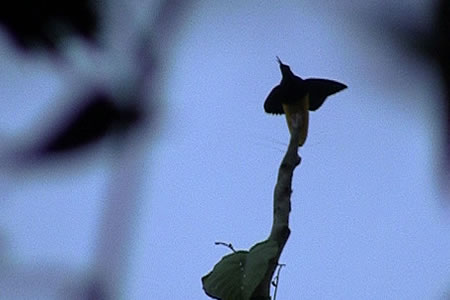 |
|
A Twelve-wired Bird of Paradise yells for attention |
|
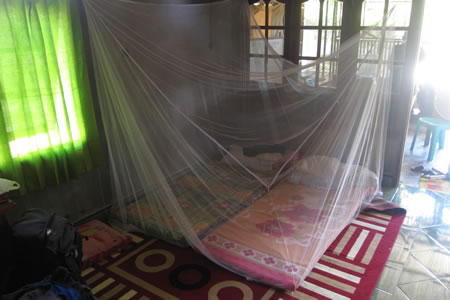 |
|
Our sleeping place in the front room of Pak Jamils' house |
|
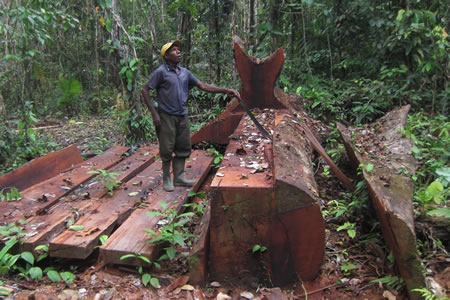 |
|
Logging is still an ongoing activity in Nimbokrang |
|
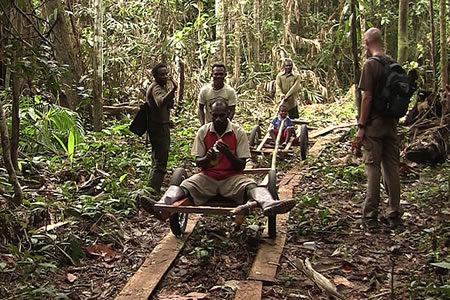 |
|
With hand carts and by using a self made railway track the wood is transported out of the forest |
|
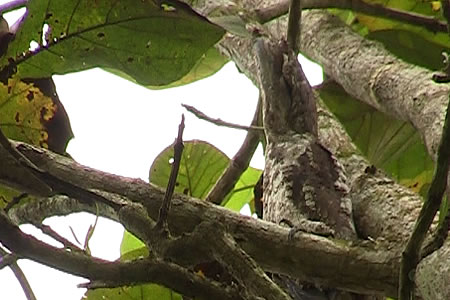 |
|
Yes, here is a bird. A huge (50 cm) Papuan Frogmouth! Who sees it? © copyright - Babakoto.eu / 2012 |
|